Introduction
- Intermodal transportation refers to “the use of two or more modes of transportation in moving a shipment from origin to destination” (Coyle, Novack, Gibson, & Novack, 2015, p. 317).
- Congestion is the bottleneck in the supply chain caused by “overburdened roadways, railways, and port facilities (Coyle et al., 2015, p. 304).
- 80% of the freight (by weight) moves into and out of the USA through ports.
- 75-80% of the shipments in the USA move through motor carriers (at least, in some parts of the entire distance).
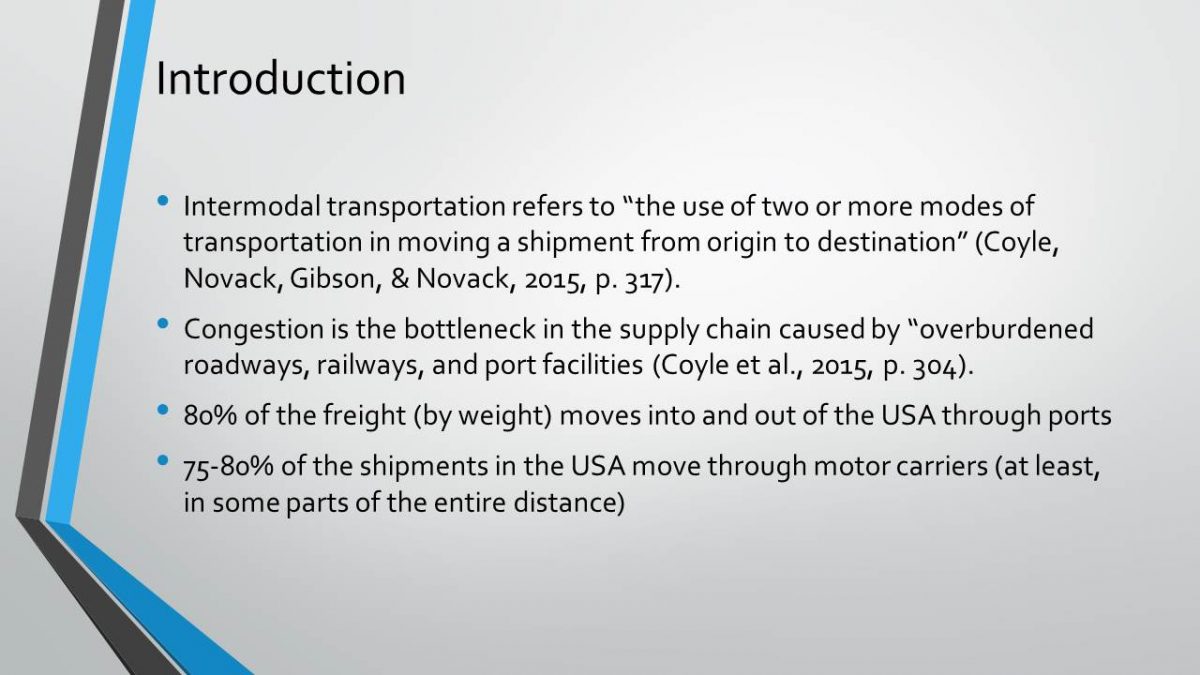
Possible Causes: Goods Movement
- Inefficient infrastructure (Rodrigue, Comtois, & Slack, 2016):
- Metropolitan area;
- Pickup and delivery facilities.
- Natural disasters and weather;
- Regulations;
- Ineffective information management.
When discussing freight movement, it is necessary to consider such areas as goods movement, physical infrastructure, and information. Possible causes for freight movement congestion of goods movement include: inefficient infrastructure, natural disasters and weather, and regulations (Rodrigue et al., 2016). The infrastructure deficiency is associated with the drawbacks of the metropolitan area with its large pedestrian and cyclists zones, narrow streets (as compared to highways), insufficient access to buildings, an insufficient number of pickup and delivery facilities, as well as ineffective routes. Some weather conditions may lead to inaccessibility of some ways and roads, which result in the overload of the unaffected routes. Various regulations can cause the congestion of goods movement as some ban can appear (in customs facilities, particular zones, and so on). Finally, improper information management may lead to the congestion of goods movement as the capacity, demand, and other important factors can be misevaluated.
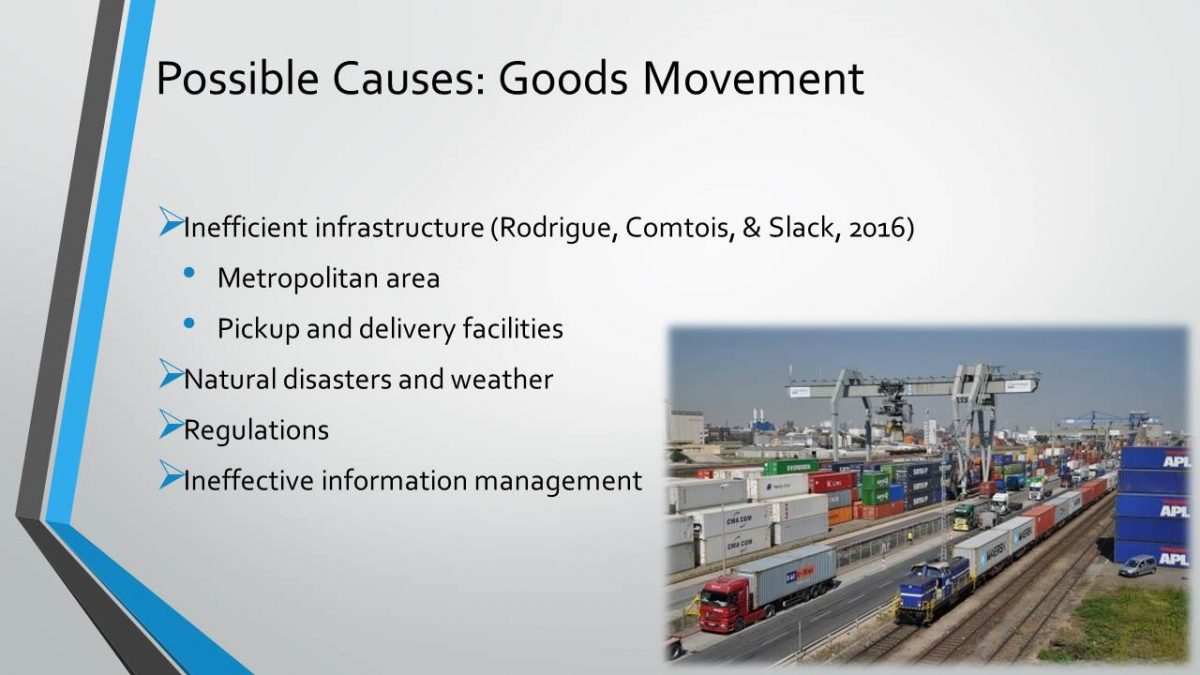
Regulations Impact
The major positive effects of regulations include:
- Introduction of standards;
- Development of different zones making the use of the existing infrastructure more effective.
One of the major positive impacts of regulations is the introduction of standards. This effect is specifically important when it comes to international transportation. For instance, the introduction of standard sizes of certain equipment boosted the development of international flow of freight (Coyle et al., 2015). Many laws and guidelines regulate such aspects as parking, use of roads and so on. These regulations are often helpful in the development of routes, construction and use of facilities.
The major negative effects of regulations include:
- Prevention of numerous technological innovations (Rodrigue et al., 2016);
- Decrease in mobility and flexibility (Fialkoff, Omitaomu, Peterson, & Tuttle, 2017).
One of the most adverse effects of regulations is the prevention of technological innovation. Officials are often unaware of the most recent technological and managerial advances. They often lack the necessary knowledge to assess different novelties. Therefore, the use of technological advances is often delayed. Another significant negative effect is the lack of mobility and flexibility. This issue is specifically apparent when it comes to addressing the aftermaths of disasters. Many regulations and guidelines can make it difficult to develop effective disaster recovery plans as some routes, equipment, and facilities cannot be accessible (Fialkoff et al., 2017).
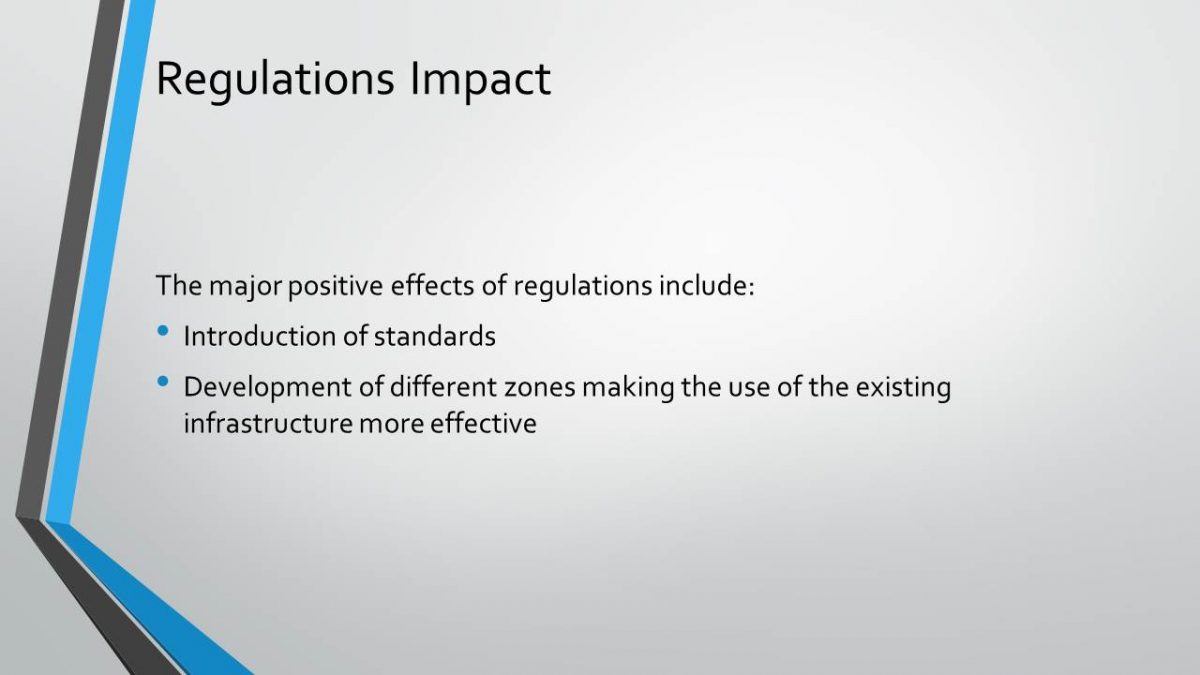
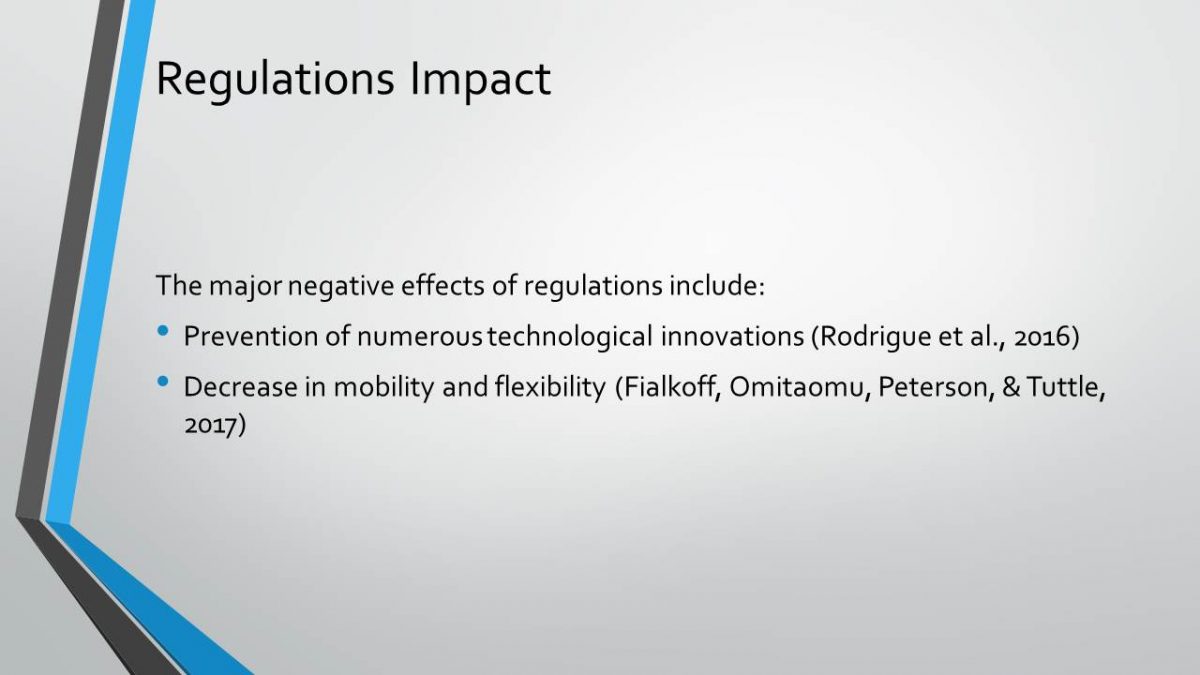
Possible Causes: Physical Infrastructure
- Ineffective urban planning (Coyle et al., 2015);
- Natural disasters and weather conditions;
- Technological and manmade disasters.
When discussing freight movement, it is necessary to consider such areas as goods movement, physical infrastructure, and information. Possible causes for freight movement congestion of goods movement include: inefficient infrastructure, natural disasters and weather, and regulations (Rodrigue et al., 2016). The infrastructure deficiency is associated with the drawbacks of the metropolitan area with its large pedestrian and cyclists zones, narrow streets (as compared to highways), insufficient access to buildings, an insufficient number of pickup and delivery facilities, as well as ineffective routes. Some weather conditions may lead to inaccessibility of some ways and roads, which result in the overload of the unaffected routes. Various regulations can cause the congestion of goods movement as some bans can appear (in customs facilities, particular zones, and so on).
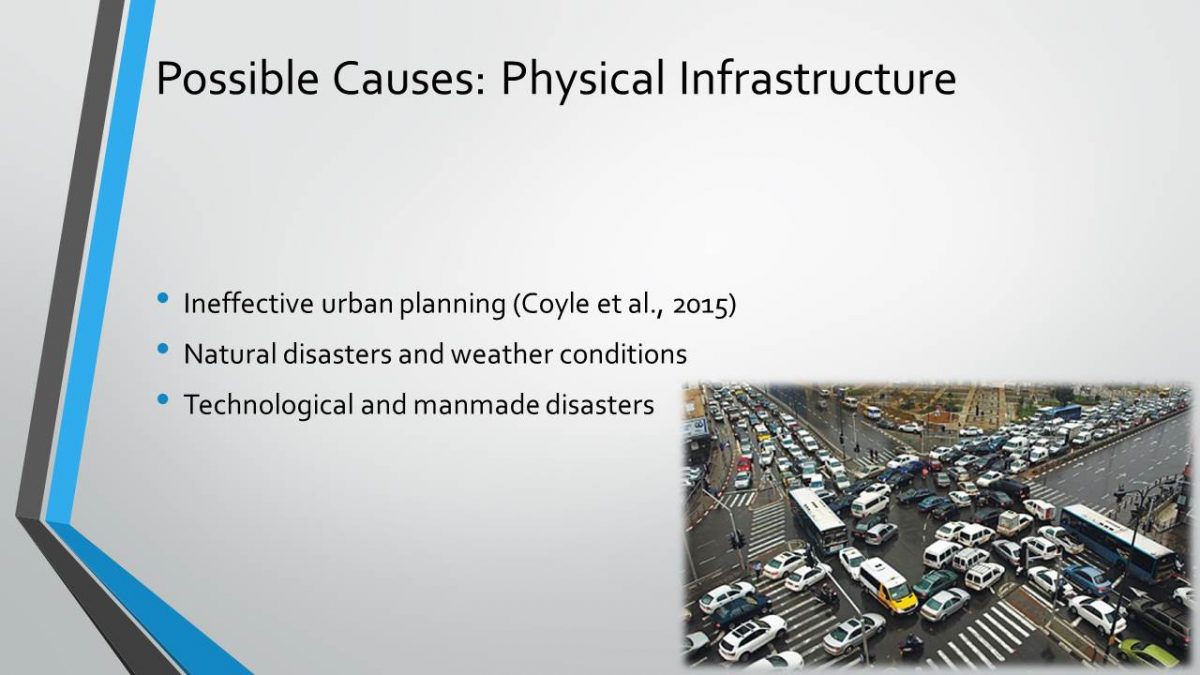
Possible Causes: Information
- Weather conditions or natural disasters;
- Hardware and software damage;
- Confidentiality breaches;
- Cyberattacks.
Information management is an essential component of effective intermodal freight movement as it ensures the safety of items and their proper flow. Therefore, impairments in information management often cause transportation congestion. Cyberattacks have become a considerable threat, and many companies suffer from them. Confidentiality breaches and similar issues can also lead to certain delays that result in congestion. Clearly, any damage to software or hardware can lead to impaired transportation movement as many operations are automatized. Finally, severe weather conditions and natural disasters can lead to the damage of communication channels or software and hardware, which will be associated with a high risk of congestion.
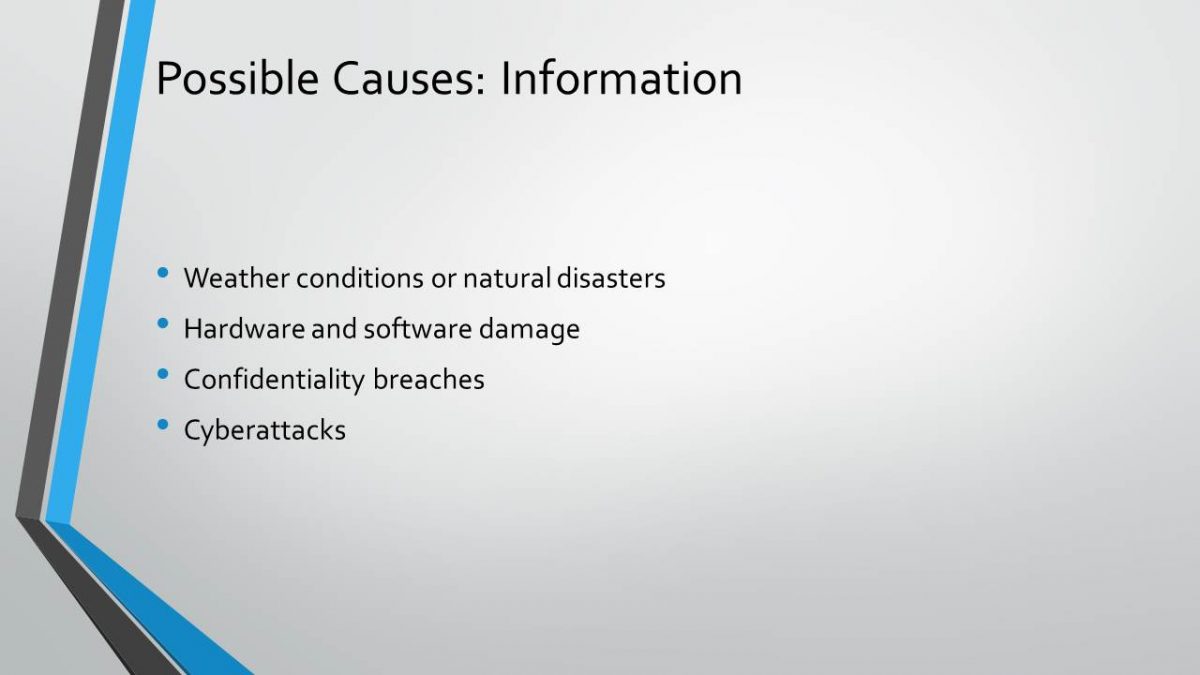
Solution for Congestion: Goods Movement
Goods Movement
- Improve the existing infrastructure:
- Increase in truck loading (and parking) zones;
- Construction of urban consolidation centers;
- Development of bicycle- and pedestrian-friendly means of delivery.
- Use of efficient Information Systems (IS);
- Incorporation of weather forecast data into IS;
- Strict adherence to and monitoring of the existing and upcoming regulations.
To address the issues associated with goods movement, it is necessary to improve infrastructure, use effective IS, incorporate weather forecast and similar data into the used IS, adhere to existing regulations and monitor any novelties in this area. The improvement of infrastructure should involve the increase in truck parking and loading zones, which will make the operations more efficient. The construction of urban consolidation centers will enable companies to optimize their logistics operations as goods will be delivered in the most appropriate vehicles in the urban setting. This solution will require the development of bicycle- or even pedestrian-friendly means to deliver goods, which will also improve the efficiency of delivery.
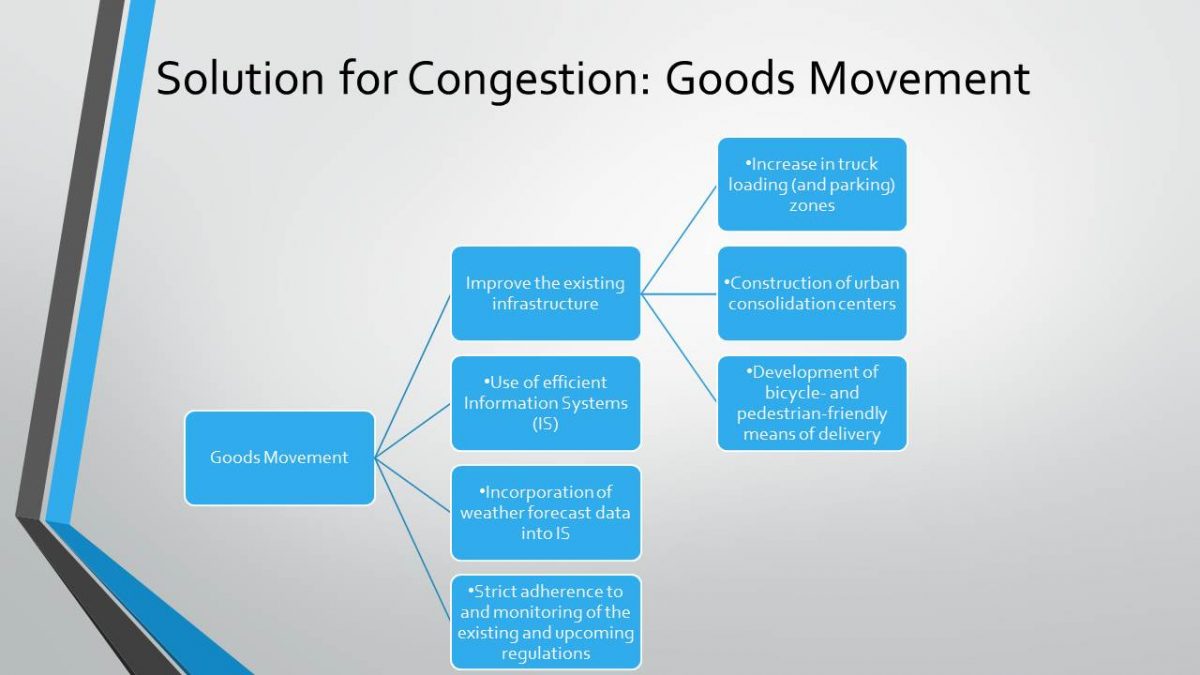
Solution for Congestion: Physical Infrastructure
- Collaboration with authorities and investment into the development of infrastructure (Coyle et al., 2015);
- Development of effective risk management plans that address such hazards as natural disasters, severe weather conditions, technological and manmade disasters, and so on.
Many companies leave the issues concerning infrastructure to authorities and keep having losses. However, leading businesses have started collaborating with authorities as they invest in the development of the existing infrastructure making it more appropriate for their operations (Coyle et al., 2015). Companies also ask authorities to share their plans for infrastructure development. These strategies are instrumental in the development of new routes and construction of various facilities. To address numerous risks including but not confined to natural and manmade disasters, companies should develop effective plans that are based on extensive research.
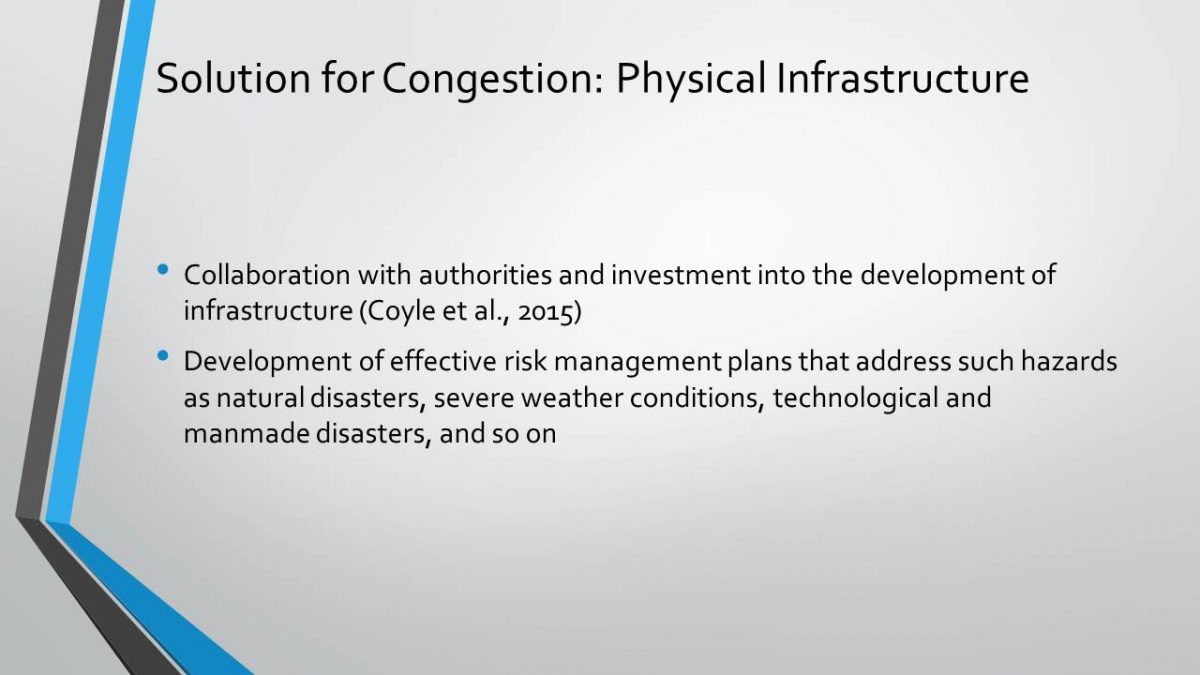
Solution for Congestion: Information
Information
- Backup plans and tools;
- Cloud-based systems;
- Effective security policy:
- Staff training;
- Control of access to data;
- Use of complex passwords;
- Encryption of files.
To mitigate the risks associated with transportation congestion caused by information-related issues, it is important to use the most advanced technology and high-profile experts (Rodrigue et al., 2016). In case of the physical damage of hardware or inaccessibility of equipment, it is necessary to use cloud-based systems and/or backup facilities, equipment, tools, and so on. Data confidentiality and security can be ensured by the development of effective (and quite strict) security policy that will involve (but will not be confined to) the control if access to data and monitoring of activity, use of complex passwords, encryption of files, as well as extensive training of the staff.

Environmental Issues Affecting Strategic Intermodal Transportation
Geographical peculiarities of different regions have a tremendous impact on strategic intermodal transportation (Coyle et al., 2015). It is important to pay attention to:
- Proximity of waterbodies;
- Temperatures;
- Landforms;
- Seismicity.
Numerous geographic peculiarities affect strategic intermodal transportation (Rodrigue et al., 2016). For instance, the proximity of waterbodies should be taken into account due to regular changes such as tides, migration of species, possible floods, ad so on. The average temperature of the area should also be taken into account as this peculiarity affects the choice of materials and construction techniques used. Landforms (such as hills, mountains, and so on) have an impact on routes, materials and construction techniques used, and so on. Seismicity is another important factor affecting strategic intermodal transportation as ways in active seismic zones should have specific characteristics. All these factors (as well as many other similar issues and geographical peculiarities) should be considered when choosing the most appropriate mode of transportation for different areas.
Global warming is another environmental concern to be taken into account (Rodrigue et al., 2016):
- The change of the landscape;
- Population migration;
- Scarcity of resources.
Global warming is one of the major environmental concerns of many authorities and individuals. It is also an environmental factor affecting the strategic intermodal transportation. The change of the landscape leads to the development of new desert areas, the change of the sea level and coastlines, the appearance of marshes and so on. The changes are rather rapid, and they have to be considered when constructing a way or a facility, as well as choosing the most appropriate mode of transportation. It is also necessary to remember that people start leaving their homes due to the lack of resources (mainly water and food). It is important to predict the changes in population density to come up with the most efficient routes and facilities locations. It is also necessary to be prepared to the scarcity of resources in some areas, which can affect the construction process.
Extreme weather is another environmental challenge that has a significant impact on strategic intermodal transportation:
- Risks of natural disasters;
- Extreme temperatures.
Extreme weathers are caused by global warming, and they are associated with a high risk of the occurrence of natural disasters. For instance, in regions where tornadoes are common, it is important to develop ways that will not be used during certain seasons. The construction of facilities in such regions should also be minimized, and the necessary cautions should be made. Extreme temperatures are becoming quite common worldwide. The dramatic change of the temperature during a year can damage ways and vehicles. It is essential to use proper materials and techniques to make sure that no processes and operations will be disrupted.
People start to focus on environmental sustainability, which affects strategic intermodal transportation in many ways including (but not confined to) such areas as:
- Gas emissions limitations;
- Preservation and conservation;
- The use of specific materials and construction techniques.
An important factor affecting strategic intermodal transportation and related to environmental issues is the modern society’s focus on sustainability. Governments try to control or rather minimize their countries’ environmental footprint. For instance, countries are trying to decrease their annual gas emissions, which has an impact on strategic intermodal transportation as some vehicles are not allowed in some zones (Rodrigue et al., 2016). Besides, some areas are not available for the development of infrastructure as they are under the protection of the government. Finally, the cost of construction is also influenced by environmental regulations as some materials and construction techniques cannot be used when constructing facilities, roadways, railways, and so on.
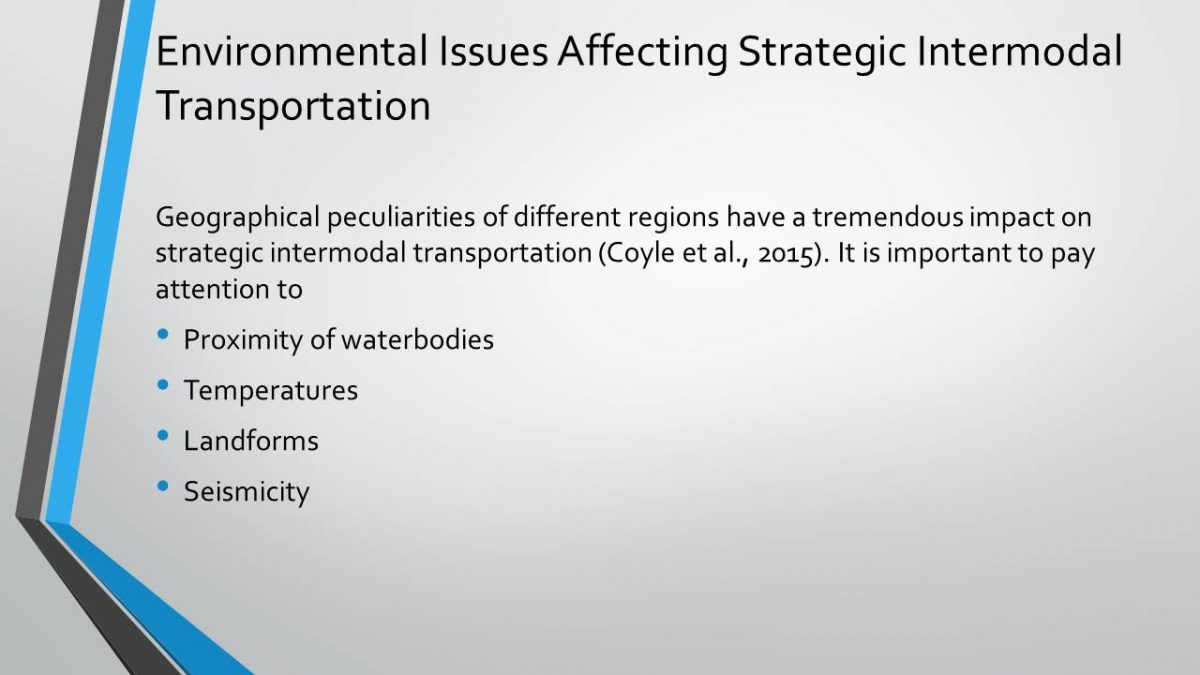
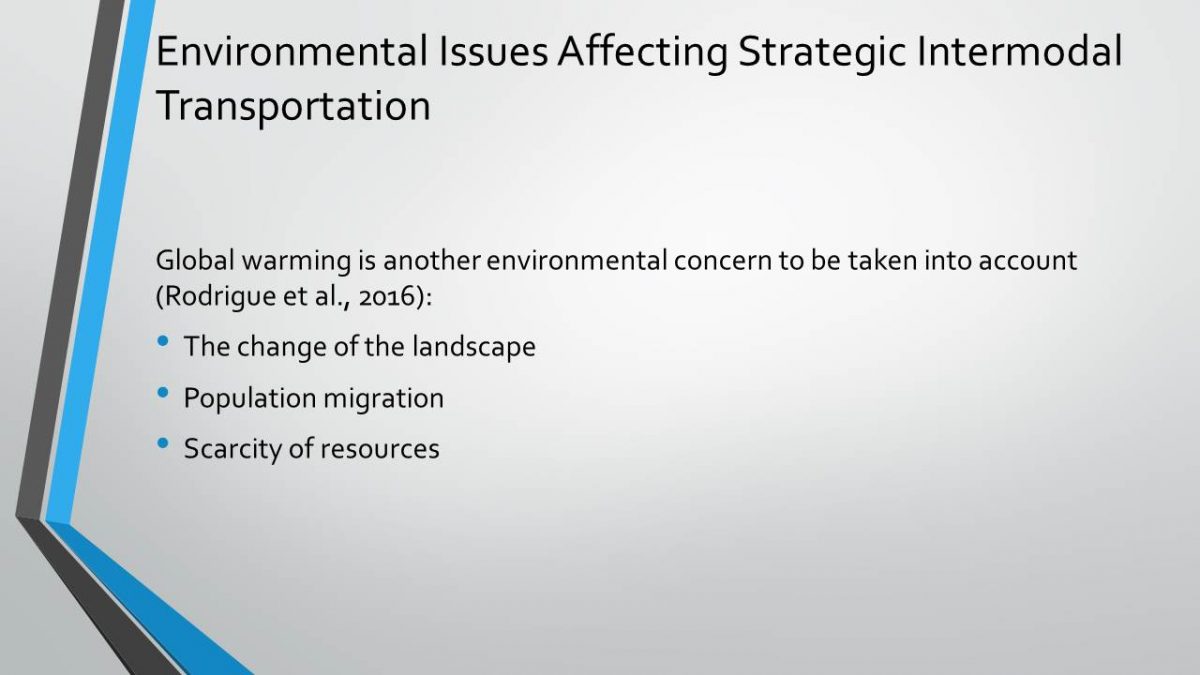
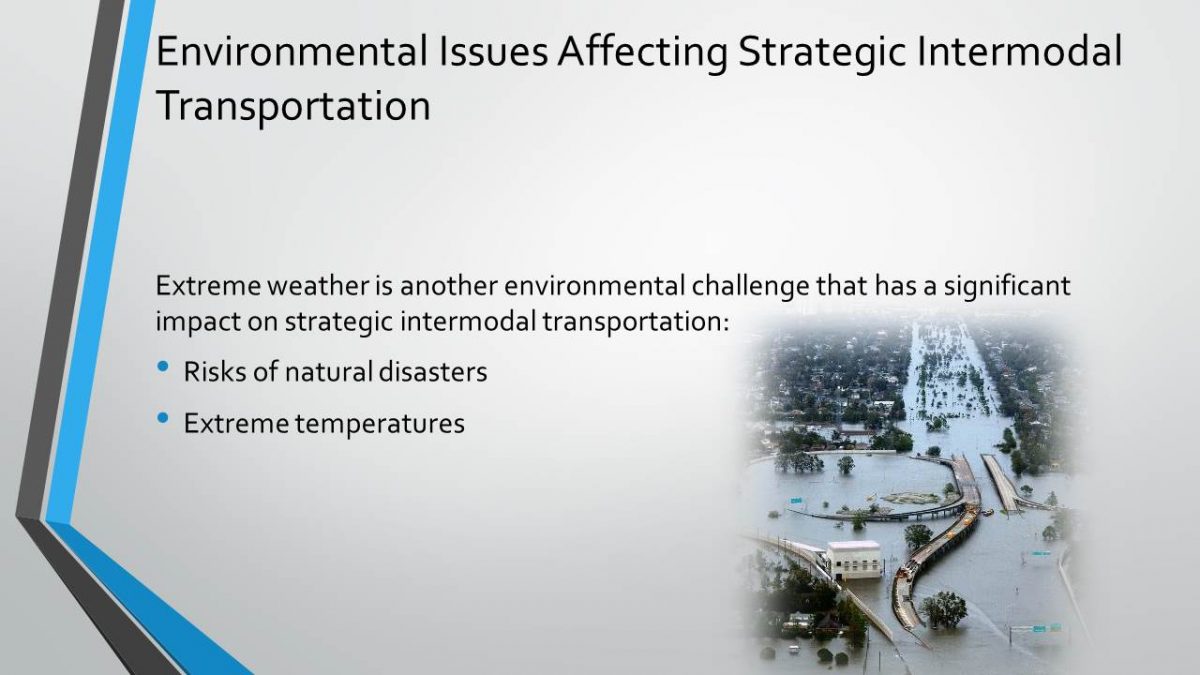
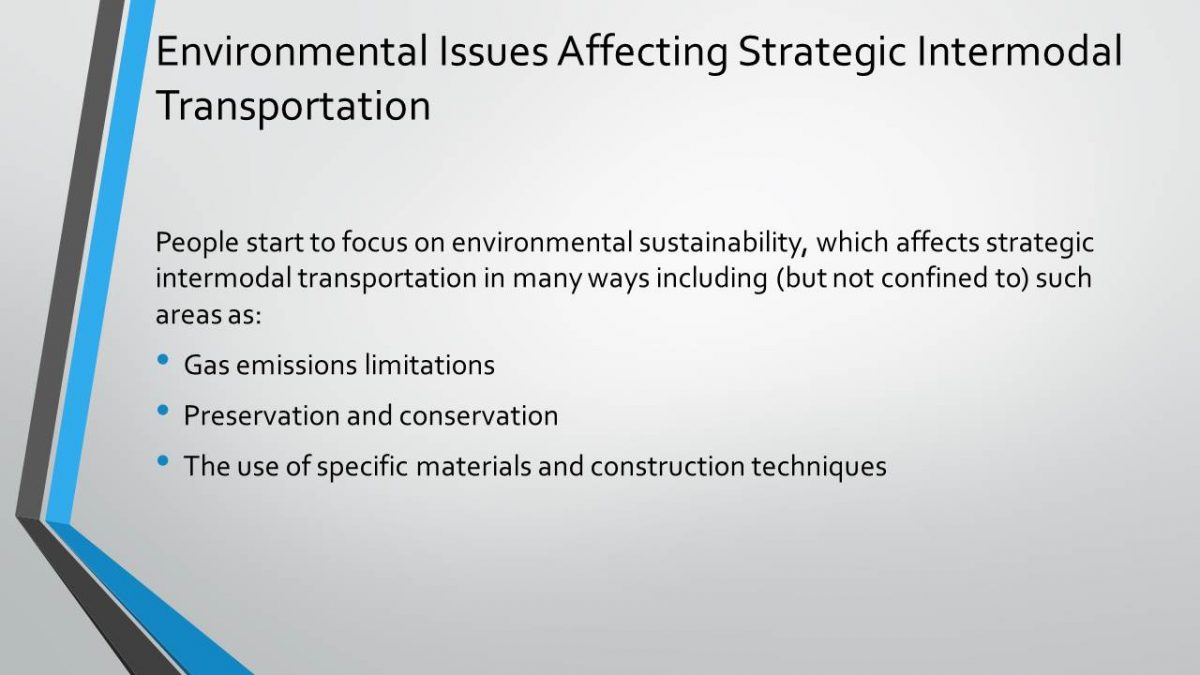
Commercial Freight Transport Capabilities
Commercial freight transport capabilities are affected by the factors mentioned above. Additionally, there are some other aspects to consider:
- Governmental control;
- Business competition;
- Public opinion.
Commercial freight transport capabilities can be affected by all the factors mentioned above. At that, other aspects can also have a considerable influence. For instance, companies have to follow numerous regulations that control their operations in terms of law. Companies shape logistics operations to improve their competitiveness. The development of facilities is also affected by the public opinion as people may prevent companies from constructing some facilities in certain areas.
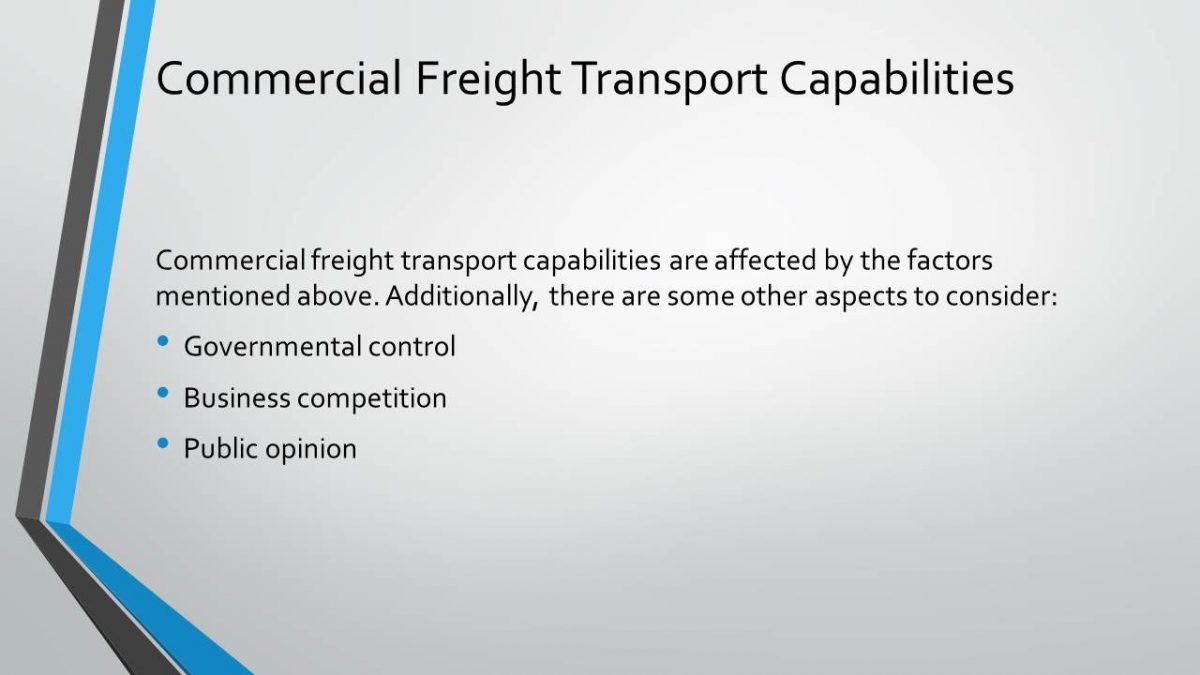
Military Freight Transport Capabilities
Military freight transport capabilities are also influenced by the factors mentioned above, but there are certain peculiarities:
- The focus on national security;
- More flexibility;
- More innovations.
Military freight transport capabilities are affected as well. Nevertheless, the influence is rather minimal as the major focus is on national security as the army should always be able to access any area to ensure the safety of people and the entire country. In many cases, (especially when it comes to US-based capabilities), commercial facilities sand ways are often used. If necessary, new facilities are also constructed. Many regulations and norms can be ignored in case of emergency. Finally, the army has advanced technologies that make military transport capabilities more efficient as compared to commercial and public.
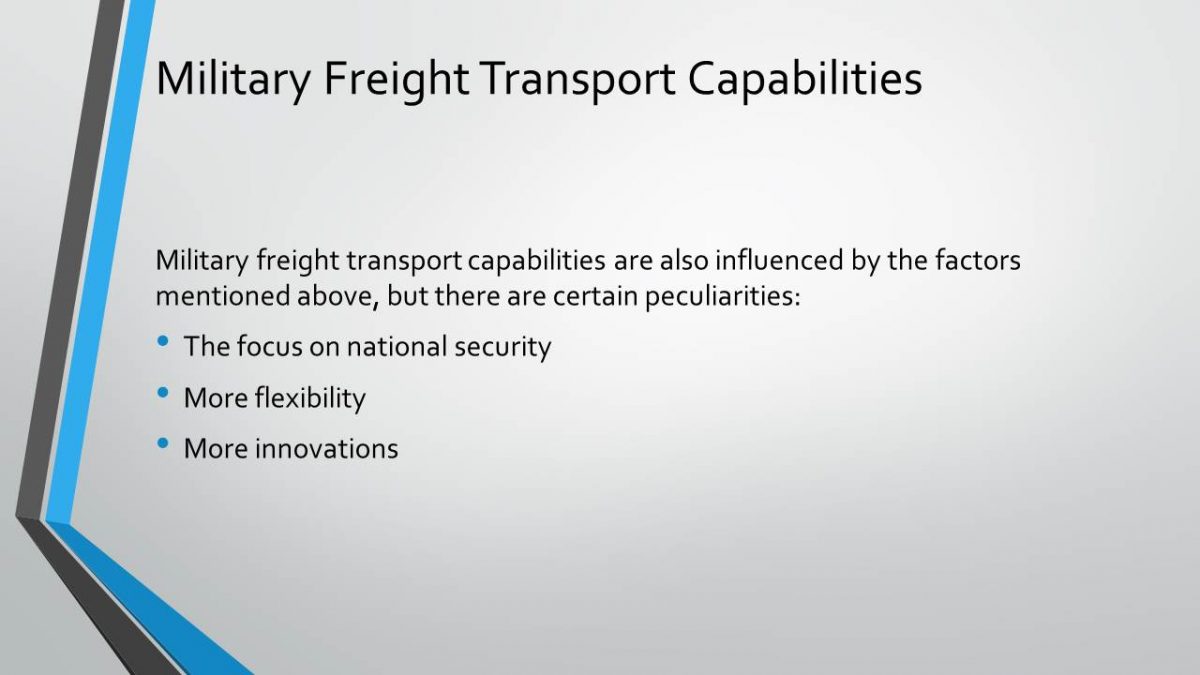
Conclusion
Addressing transportation congestion
- Improve the existing infrastructure through investment and collaboration with authorities;
- Strictly adhere to and monitor the existing and upcoming regulations;
- Use efficient Information Systems (IS), incorporate weather forecast data into IS;
- Develop effective risk management plans, back-up plans and tools;
- Use cloud-based systems, effective information security policy.
The major causes of transportation congestion include: ineffective infrastructure, natural and manmade disasters, regulations, and improper information management. Companies should consider undertaking a number of steps including but not confined to the improvement of the existing infrastructure through investment and collaboration with authorities, strict adherence to and monitoring of the existing and upcoming regulations, use of efficient Information Systems (IS), incorporation of weather forecast data into IS, development of effective risk management plans, backup plans and tools, use of cloud-based systems, and development of effective information security policy.
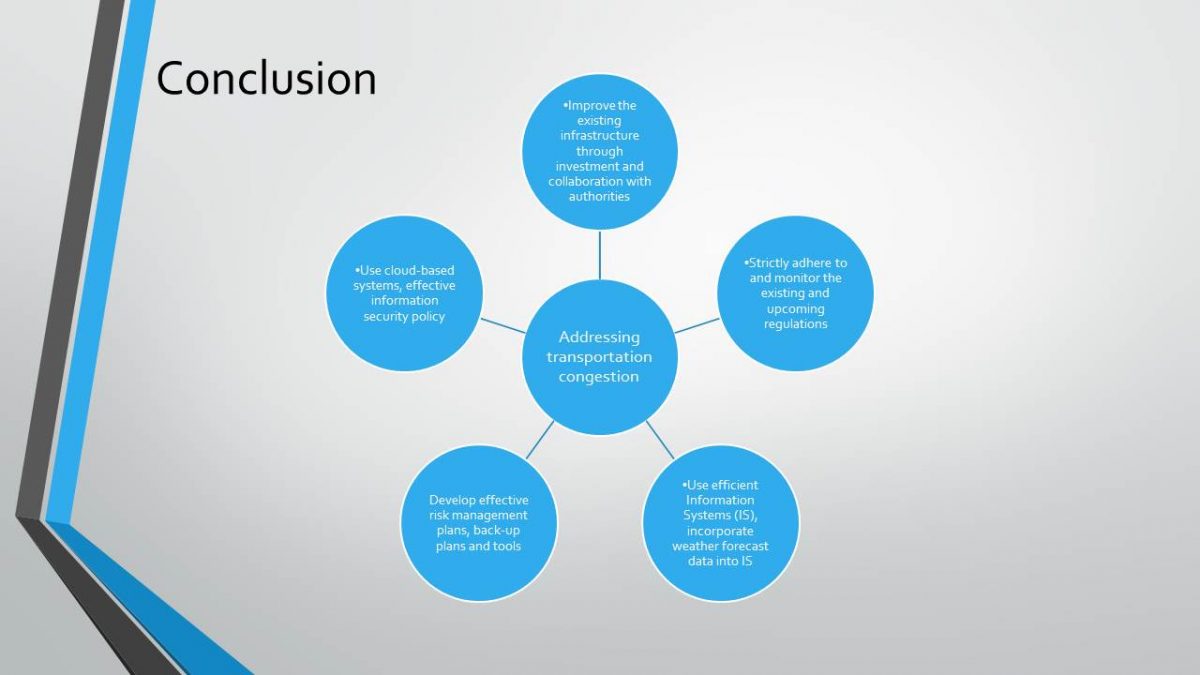
References
Coyle, J., Novack, R., Gibson, B., & Novack, R. (2015). Transportation. Boston, MA: Cengage Learning.
Fialkoff, M., Omitaomu, O., Peterson, S., & Tuttle, M. (2017). Using geographic information science to evaluate legal restrictions on freight transportation routing in disruptive scenarios. International Journal of Critical Infrastructure Protection, 17, 60-74.
Rodrigue, J., Comtois, C., & Slack, B. (2016). The geography of transport systems. New York, NY: Taylor & Francis.